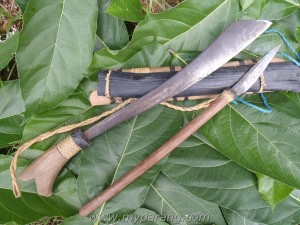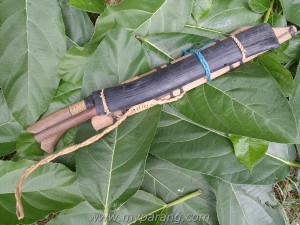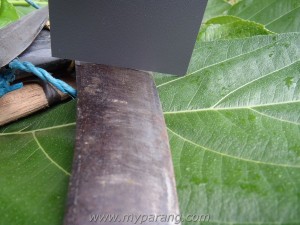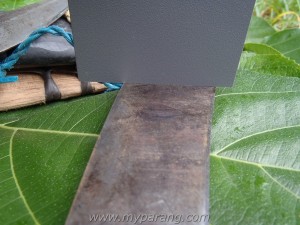Kota Belud Parang
 Here are two parangs that I bough from Kota Belud, Sabah. Kota Belud is a township very famous for it’s Tamu or weekend market. Kota Belud also is well known for their Bajau or sea Gypsies. Traditionally they are very skillful parang and knife makers, and the kota belud parangs are well known throughout Malaysia as being great parangs .
Here are two parangs that I bough from Kota Belud, Sabah. Kota Belud is a township very famous for it’s Tamu or weekend market. Kota Belud also is well known for their Bajau or sea Gypsies. Traditionally they are very skillful parang and knife makers, and the kota belud parangs are well known throughout Malaysia as being great parangs .
As you can see form the above photo, the parang they make have a very distinct shape, with a sheep’s foot tip. They make various sizes and weights, from those suitable for general work around the house to more dedicated choppers ( for trees and bones ) . Material used is the good ol recycled leaf spring or also known as 5160 steel .  Another signature mark is their carves sheaths, just like above . Some are simple , like the close up below, but some kota belud parangs have very intricate sheath carvings. There is also an annual Kota Belud parang competition, where you can see dazzling displays of very very well made kota belud parangs. Most of the parangs use exotic wood like Serian, Kemuning Hitam, Kayu Malam and others. The carvings on the sheath and finishing are top notch.
Another signature mark is their carves sheaths, just like above . Some are simple , like the close up below, but some kota belud parangs have very intricate sheath carvings. There is also an annual Kota Belud parang competition, where you can see dazzling displays of very very well made kota belud parangs. Most of the parangs use exotic wood like Serian, Kemuning Hitam, Kayu Malam and others. The carvings on the sheath and finishing are top notch.
The Below pictures shows the kota belud parangs without their sheath, as you can cee the one on the right has much more weight to it and is suitable for chopping bones and trees. The one on the right is a much slimmer version with less weight and is suitable for clearing small shrubs. I have used both, but I prefer the smaller kota belud parang on my outdoor trips. It packs down much smaller and is lighter to carry around.  Besides the Chandong parang shape as the ones in this post, the other typical blade shapes in Kota Belud is the Barong . Unfortunately, I do not have any with me at the moment, and will look at getting some in the future.
Besides the Chandong parang shape as the ones in this post, the other typical blade shapes in Kota Belud is the Barong . Unfortunately, I do not have any with me at the moment, and will look at getting some in the future.









